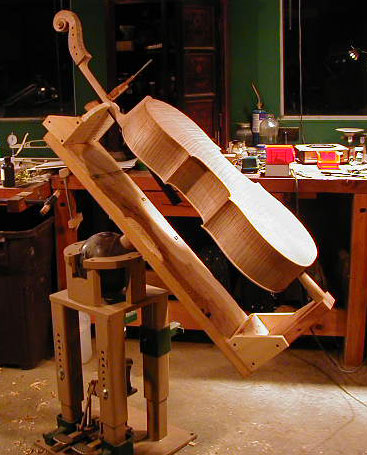I've looked for a means to immobilize a cello on my bench, and was wondering if there are any willing to share their methods. I've worked on violins by clamping the neck in a padded vise, but obviously a cello is a tad heavy for that. Thanks for any ideas.
Views: 936
Replies to This Discussion
-
What are you wanting to do that requires immobilization? There are nice benches built for this, but in forty years of repairing cellos, I've never felt the need to invest in one. What are you trying to do?
-
There are several separations between the back and belly and the ribs. One crack as well. Just wondering if there are any good ways to immobilize it on its back to facilitate clamping. Need to fit a new bridge, too, and like to work on things as comfortably as possible. Blocks may work. Was looking for the most logical method. Thanks.
-
I have some wood blocks of various sizes with cork padding on top. i support the rim on these to prevent rocking on the bulgey part.
-
I have a number of suggestions (absent the big jig), but I still wish Randall would check in.
-
Pics of prospective victim: E.R. Pfretzschner dated 1971 Mittenwald. Actual body size is approx. 29 3/4 inches.
- Attachments:
-
You need a clean, padded bench, so when it is on its back, you can't scratch it. To get glue into open seams, you need to move the cello quite a lot, so you certainly don't need to immobilize it. I generally use gravity to help brush glue into the seams, and do the clamping (spool clamps) with the cello on its side, not laying flat.
Fitting bridges is also much easier when you can move the cello while you do it. If you want to keep it level and in one place for some reason, Greg's block idea is good. Some folks use foam, some bags with lead shot inside.
About the only operation I do with the cello affixed solidly is planing and dressing the board.
-
Good advice. Have been experimenting with the steam method http://www.thestrad.com/pdfs/hamtradesecrets.pdf
written up by James Ham, so was looking at working the glue in, then steam/clamp, steam/clamp as he demonstrates so well. I think he presented at the GAL meeting last year; at least I think the magazine was where I first saw it. Thanks much for the tips.
-
Do not try this at home. At least on anything valuable.
-
Love the bowling ball!
-
I found a dental chair but no one will let me pull teach but it works great fo repairing stand up bass
Ron
-
I would probably use that once every couple of years, at best, but that doesn't stop me from wanting one!
© 2025 Created by Frank Ford.
Powered by
![]()
